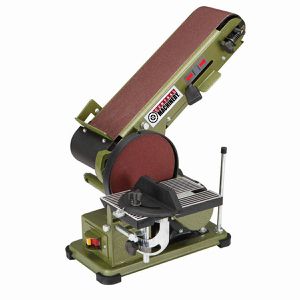Difference between revisions of "Belt Sander Sanding Station"
(→Advanced Operational Knowledge) |
(→Advanced Operational Knowledge) |
||
| Line 49: | Line 49: | ||
== Advanced Operational Knowledge == | == Advanced Operational Knowledge == | ||
| − | There are some more advanced tasks that not everyone needs to know to do for general use, but needs to know to replace sanding belts and disc or troubleshoot | + | There are some more advanced tasks that not everyone needs to know to do for general use, but needs to know to replace sanding belts and disc or troubleshoot. |
| + | |||
| + | '''Turn OFF power switch and unplug before performing any procedure in this section''' | ||
===Belt Replacement=== | ===Belt Replacement=== | ||
Revision as of 07:33, 21 June 2015
- Owner/Loaner: Randy Keeling
- Serial Number: Serial Number
- Make/Model: Make/Model of equipment
- Arrival Date: Sept 2014
- Usability: {{{usagerestrictions}}}
- Contact: info@themakerstation.com
- Where: Back wall near roll up door
Contents
Info
4" x 6" Combination sander with adjustable belt sands inside and outside curves.
General Specs
- 6 in. disc 1819 rpm
- 4 x 36 in. belt 1185 fpm
- Cast aluminum table tilts to 60° for use with belt or disc
- 3/4 HP motor
- Miter gauge for beveling
Permissions
- For general use by members.
- Treat equipment as if it were your own and put away as or better than you found it.
Restrictions
- Safety glasses required
- Closed toed shoes required
- No long sleeves or loose clothing
- Long hair must be tied back
Basic Instructions
Manual - OEM Instruction Manual
- Make sure that the Switch is in the off-position, then plug in the tool.
- Insert Safety Key into Switch.
- Make sure nothing is contacting the Sanding Disc or Belt, then turn on the Switch.
- . When using the Disc Sander, only use the LEFT side of the Sanding Disc (as you face it) to sand. The Sanding Disc turns counterclockwise and using the right side could cause kickback.
- Use two hands and hold workpiece securely against the fence/table at all times. Press the workpiece against the belt/disc to start sanding. Keep the workpiece moving for a better finish.
- After use, turn off the tool, remove the Safety Key from the Switch, and disconnect from the power supply. Clean and store the tool indoors out of children's reach
Advanced Operational Knowledge
There are some more advanced tasks that not everyone needs to know to do for general use, but needs to know to replace sanding belts and disc or troubleshoot.
Turn OFF power switch and unplug before performing any procedure in this section
Belt Replacement
- Push the Belt Tension Handle (50) forward to loosen the belt.
- Remove Upper Guard Plate (58) by unscrewing four Screws (7).
- Remove the Lower Guard Plate (60) by unscrewing the four Screws (7) that hold it to the Belt Support Housing (52).
- Slide the old Sanding Belt off the Rear Roller (56) and Front Roller (44).
- Replace with a 4" X 36" Sanding Belt with the correct grit for the project you are working on. Note: The larger the grit number, the smaller the grain. Use small numbered grits for cutting and larger for smoothing and finishing.
- Slide a new Sanding Belt onto Front and Rear Rollers.
- Replace the Lower Guard Plate and tighten the four Screws securely.
- Replace the Upper Guard Plate and tighten the four Screws.
- Push the Belt Tension Handle to the rear to tighten the belt.
- Before using, manually check the new belt for alignment. See instructions in the “General Operating” section of this manual.
Disc Replacement
- Remove the Table (69) if it is mounted in front of the Sanding Disc.
- Peel off old Sanding Disc.
- Align perimeter of new Sanding Disc over the Backing Disc (5) and press firmly onto the Backing Disc.
V-Belt Tensioning and Replacement
Warnings
- Keep loose hair and sleeves away from all moving parts
- Beware parts may become hot after use
- Beware of dust, fumes, choking hazards
Safety
FILL THIS OUT THOROUGHLY
- x
- y.
References
- links as needed
